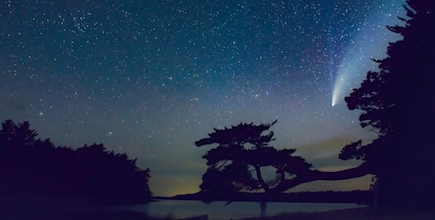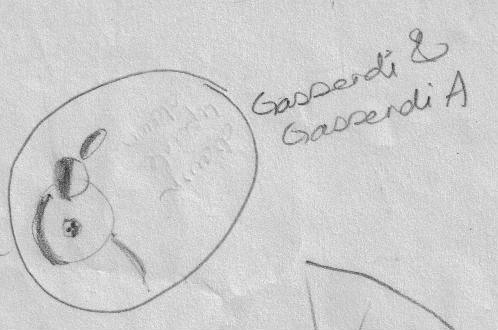Phase - Waning Gibbous (92.3%), 2 days past full Moon on August 29/15
Features Observed: Cleomedes, Mare Crisium, Langrenus, Vendilinus, Petavius, Funerius
Location: Lower Sackville, NS
Date: 2015-08-31
Time: 10:29 PM
Equipment: Binoculars 10x30 IS
Magnification: x10
Seeing: not recorded
Transparency: not recorded
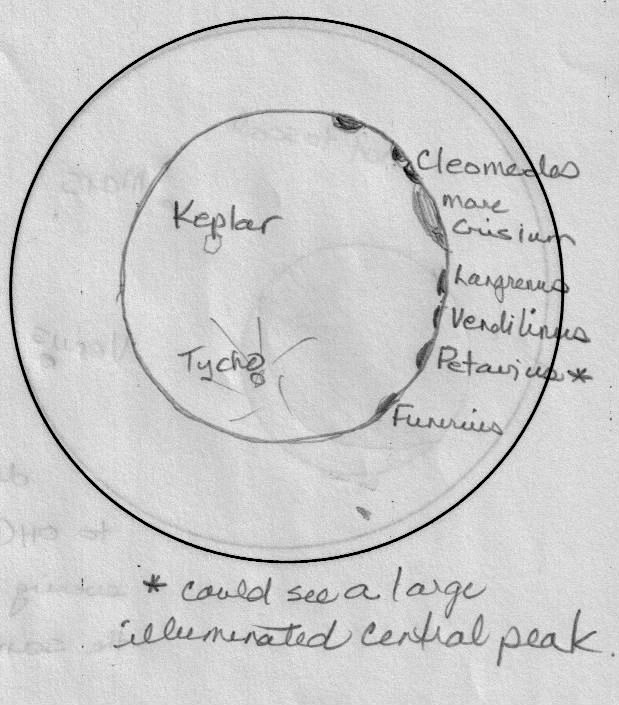
- Details
- Hits: 1957
Phase: Waxing Crescent (35.8%)
Location: Home
Date: 2016-09-07
Time: 8 PM start; undocumented end time
Equipment 1: binoculars 10x30 IS
Equipment 2: Meade LX200, 26 mm + 45 mm eyepieces
Magnification: x10
Seeing: not recorded
Transparency: not recorded
Jerry came in to alert me the Moon was high in the sky, i.e., above our trees. He set up the Meade LX200 for me. After polar aligning it for viewing all evening, we used the directional controls to locate the Moon and to find some of its features. Also used my 10x30 IS binoculars. Clear night with no clouds. 19° C.
Moonrise: 12:41 PM Moonset: 10:59 PM
Sunset: 7:40 PM Sunrise: 6:44 AM
|
Lunar Basins: Impact Craters: |
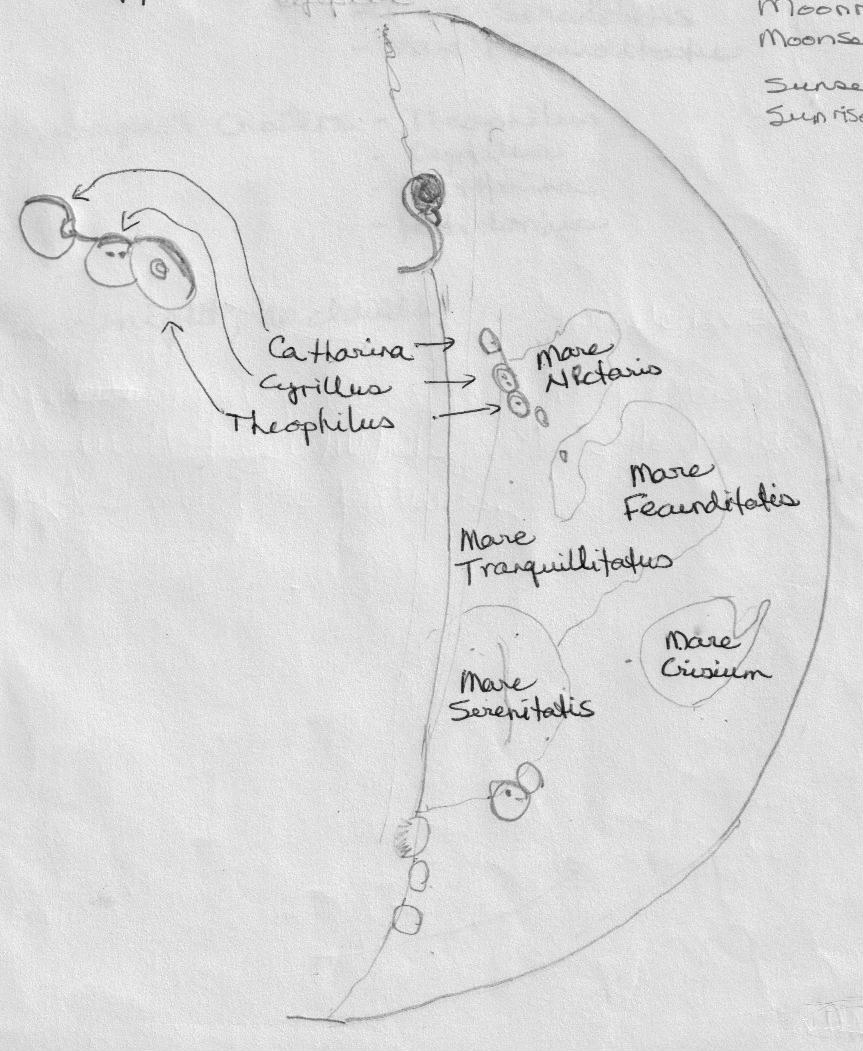 |
- Details
- Hits: 1818
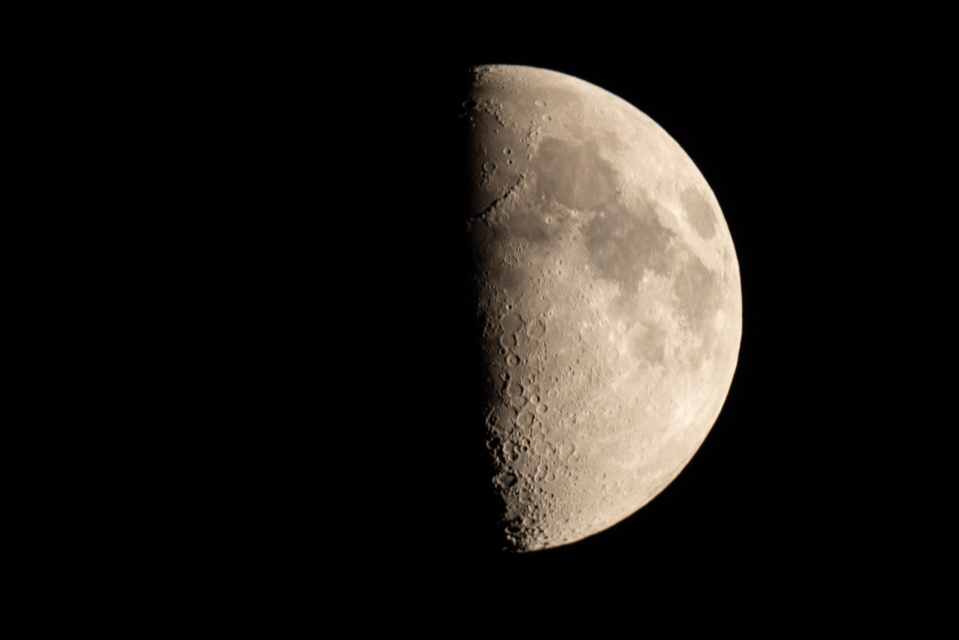
© Jerry Black - Nikon D800, ISO 100, 1/15 sec @ f/3.5 |
Lunar Phase: 1st Quarter (46.6%) Location: Home |
The evening began with the First Quarter Moon visible above the trees. This evening is to be devoted to Moon watching but will look at constellations and DSOs when we can do so. Jerry has the Meade LX200 set up with his camera so this session for me is through two pairs of binoculars - 10x30 IS and 15x70.
9:00 - 9:30 PM:
Reinforced ability to view the following seas: Crisium, Fecunditatis, Serenitatis, Tranquilitatis.
New to my observations tonight were:
a) Mare Vaporum
b) Mare Frigoris & Lacus Somnorium
c) eastern portions of Mare Imbrium
d) Alps Mountains on the north shore of Mare Imbrium
e) Could make out the line of the Apennine Mountains running SW to NE at the bottom of Mare Imbrium and north of Mare Vaporum
f) Could make out the large, oval-shaped crater Petavius on the southern border of Mare Fecunidtatis.
g) Cleomedes was visible above the north shore of Mare Crisium. It wasn't attached to the Mare.
h) Oval-shaped Posidonis was seen on the shore between Mare Serenitatis and Lacus Somnorium.
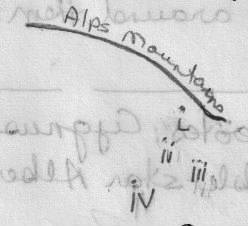 |
i) Just south of the Alps were the following craters: i- Cassini ii- Aristillus iii- Autolycus (the smallest) iv- Archimedes (the largest) |
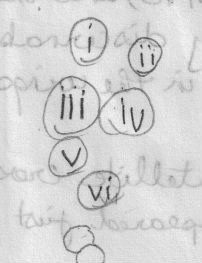 |
j) Sinus Medii below which I could easily see the following craters (top to bottom): i- Herschel ii- Hipparchus iii- Halley iv- Ptolomaeus v- Alphonsus vi- Arzachel |
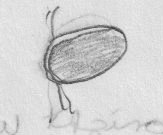 |
9:30 - 9:45 PM: Could see the crater Plato on the terminus. It was bright on the rim (western edge) whereas most of the crater and its eastern edge were in shadow. |
9:45 - 10:00 PM:
My focus was the lower quadrant, trying to identify, if at all, the "Gang of Four" craters. I am quite sure I found Vendilinus and Petavius. If I identified Furnerius, it was the centre of a feature that looked like a mini-Tycho. Was not sure about Langrenus. All the craters were whiter than the surfaces around them; no ridges were detected by shadows.
10:00 - 11:00 PM:
Spent the time on constellations as found in General Session - September 9, 2016
- Details
- Hits: 1937
Phase: Waxing Crescent (7.2%)
Location: Swiss Air Monument
Date: 2016-09-03
Time: 8:30 PM start; undocumented end time
Equipment: Visual
Seeing: not recorded
Transparency: not recorded
Jerry and I were setting up for time-lapse imaging and binocular observing respectively. We watched as the crescent went down below the horizon as a red-orange sliver. Absolutely breath-taking and so amazing at how quickly it "disappeared" at the horizon. Took a picture of it but Jerry deleted it when formatting the card for time-lapse.
- Details
- Hits: 1844
Phase: Waxing Gibbous (75.2%)
Location: Home
Date: 2016-09-12
Time: 8:20 PM start; undocumented end time
Equipment: 10" Meade SCT, 40 mm + 30 mm Antares 2" eyepiece
Magnification: x63 + x83
Seeing: not recorded
Transparency: not recorded
Clear sky with only a light wind. First Quarter was 3 days ago at 8:50 AM
Moonset: 2:02 AM Moonrise: 4:58 PM
Sunrise: 6:50 AM Sunset: 7:30 PM
Mare: Mare Hurmorum, Mare Iridum
Craters: Copernicus, Encke, Gassendi + Gassendi A Kepler, Lansberg, Plato, Reinhold, Tycho
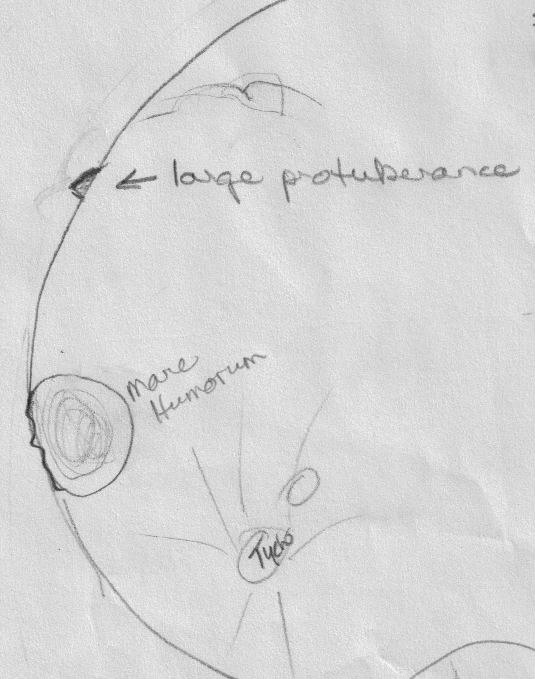 |
There was a large protuberance on the terminus in the area of Mare Iridum. I could not identify the lunar feature that would have been illuminated so well. Maybe the Jura Mountains?
|
- Details
- Hits: 1892
Phase: Waxing Gibbous (64.6%)
Location: Home
Date: 2016-09-22
Time: 8:15 - 8:49 AM
Equipment: 8" Meade LX200, 40 mm eyepiece
Magnification: x30
Seeing: good
Transparency: good
Sunny, 14°C.
Moonset: 1:42 PM Moonrise: 11:35 PM
Sunrise: 7:02 AM Sunset: 6:54 PM
Craters:
Now that the sun was up, the features were somewhat bright but not completely washed out. Drew some of the features I saw but I obviously did not make much attempt at identifying them other than Posidonius and Tycho. At this point, I was getting used to the newly acquired 8" Meade SCT "push-to" telescope. With the star diagonal, I was sometimes confused as things were not only backwards (as they should be) but felt as though sometimes they were backwards and upside-down. Don't ask - I can't explain.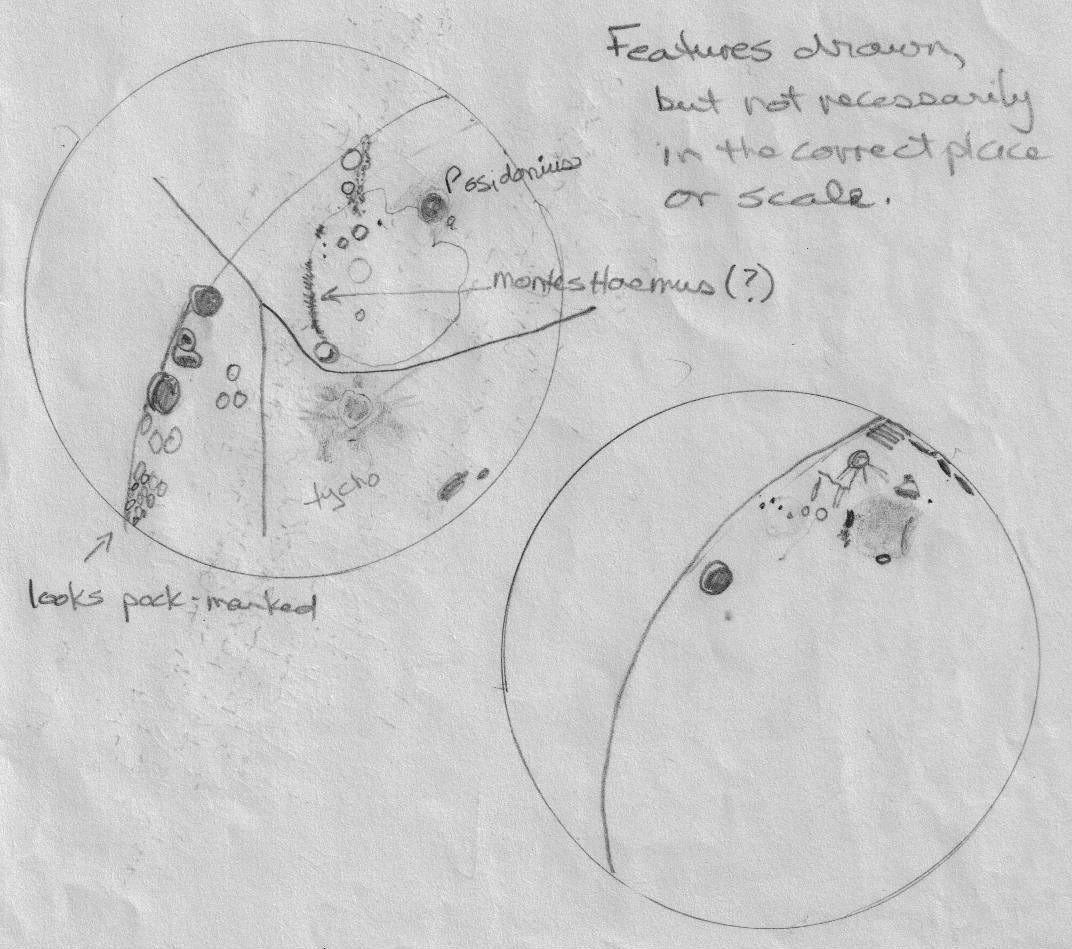
- Details
- Hits: 1782
Phase: First Quarter (55.8%)
Location: Home
Date: 2017-03-05
Time: 7:33 PM - 9:40 PM
Equipment: Binoculars 10x30 IS
Magnification: x10
Seeing:
Transparency:
Hazy sky, -12°C, windy. This session was followed by General Session - March 5, 2017
Moonrise: 11:14 AM Moonset: 1:14 PM
Sunrise: 6:45 AM Sunset: 6:08 PM
Montes Apennine:
Apennine Mountains very easily seen; caught your eye because of their brightness.
Mare Located:
Fecunditatis, Frigoris, Nectaris, Serenitatis, Tranquilitatis, Vaporum
| Craters: Alphonsus, Arzachel, Klein and Ptolomaeus plus two small craters were on the lower half of the terminus. Upper part of the terminus was rough (craters? mountains?) compared to the terminus between Ptolomaeus and this feature. |
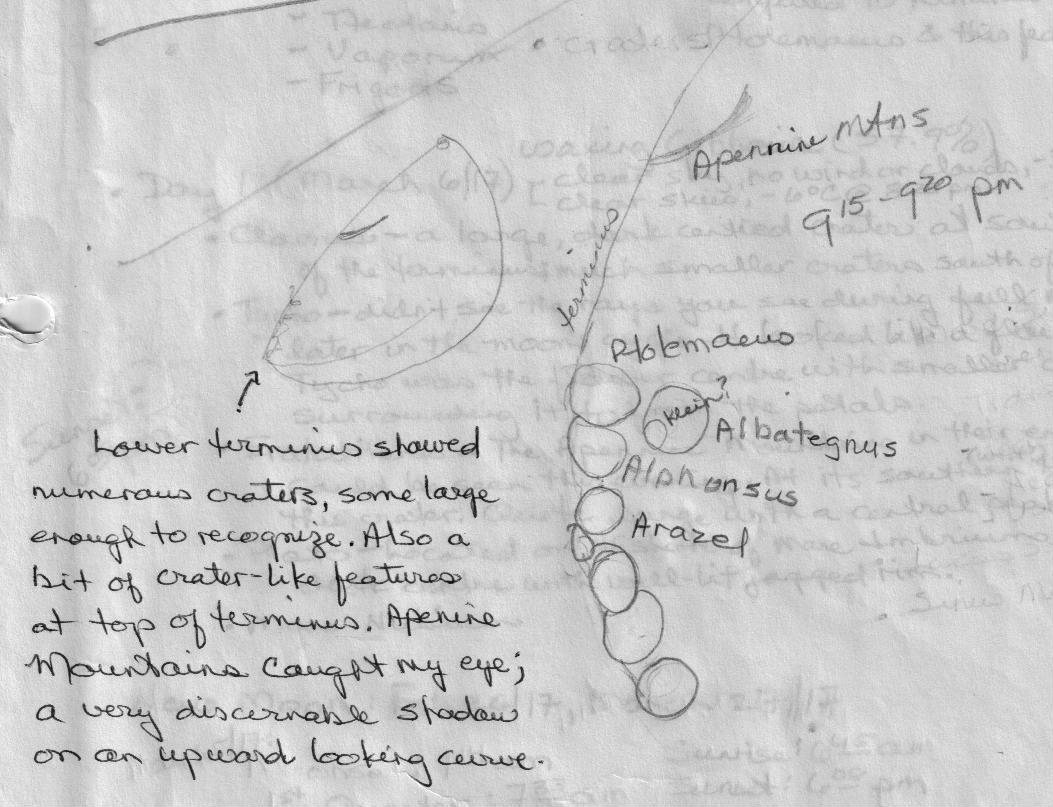 |
| Visual: Thin cloud plus perhaps the First Quarter Moon made for poor visibility of the Winter Circle but was able to see some of the stars around the Moon plus the adjacent Pleiades. NOTE: The dark line across the image is not an astronomical feature; it was the line drawn between this sketch and the one above. |
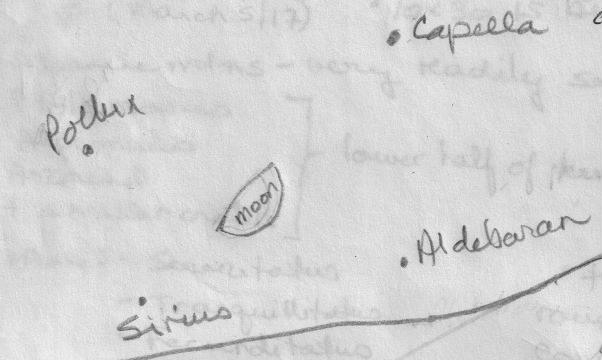 |
- Details
- Hits: 1556
Phase: Waxing Crescent (17.1%)
Location: Home
Date: 2017-01-31
Time: 7:10 - 7:30r PM
Equipment: Binoculars 10x30 IS
Magnification: x10
Seeing: not recorded
Transparency: not recorded
Clear sky, -5°C. This was part of General Session - January 31, 2017 .
Moonrise: 9:32 AM Moonset: 9:35 PM
Sunrise: 7:35 AM Sunset: 5:22 PM
| Conjunction of Moon - Mars - Venus: This was first observed low on the horizon. Seen from our bedroom window. The Moon and Venus were easily discernible compared to Mars. According to the 2017 RASC Observer's Handbook, they should fit in a 6° circle in the evening sky. All 3 objects were visible in the same FOV in my binoculars. |
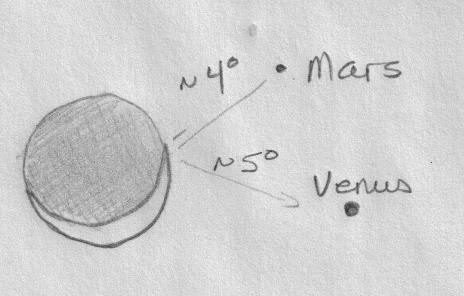 |
- Details
- Hits: 1964
Phase: Waxing Gibbous (57.9%)
Location: Home
Date: 2017-01-31
Time: 5:30 - 9:30 PM
Equipment: 8" Meade LX200
Magnification: unknown
Seeing:
Transparency:
-3°C at 5:30 PM, -6°C at 8:25 PM.
Clear sky, little or no wind and no clouds throughout the session. Following the session where the Moon features were identified and logged, it was General Session - March 6, 2017.
Moonset: 2:18 AM Moonrise: 12:06 PM
Sunrise: 6:43 AM Sunset: 6:09 PM
Clavius:
A large, dark centred crater at the south end of the terminus; much smaller craters south of Clavius.
Tycho:
Didn't see the rays you see during the Full Moon or later in the Moon's cycle. It looked like a flower - Tycho was the centre with smaller craters circling it like petals.
Eratosthenes:
The Apennine Mountains in their entirety could be seen this evening. This crater was at its southern tip. Quite large with a central peak.
Plato:
Located on the NE shore of Mare Imbrium. Large, dark centre with well-lit jagged rim.
Located Mare Nubium.
- Details
- Hits: 1524
Phase: Waxing Crescent (35.7%)
Location: The Gonzo Inn, Moab, Utah
Date: 2017-05-30
Time: 9:25 PM (MT)
Equipment: Binoculars, 10x30 IS
Magnification: x10
Seeing: good
Transparency: good (when clear)
Temperature: 21° C
Mostly clear sky with occasional cloud. I stood at an outdoor causeway between units at the hotel and had a clear view of the Moon. No Earth shine.
Moonset: 12:30 AM Moonrise: 11:13 AM
Sunrise: 5:56 AM Sunset: 8:35 PM
Mare: Mare Fecunditatis, Mare Nectaris, Mare Tranquilitatis
Craters: Catharina, Cyrillus, Theophilis.
Theophilis and Cyrilius are a little more than 1/3 down the terminator.
- Details
- Hits: 1611
Phase: Waxing Crescent (46.3%)
Location: Demotte Campground in Grand Canyon National Park
Date: 2017-05-31
Time: 8:37 PM MDT
Equipment: Binoculars, 10x30 IS
Magnification: x10
Seeing: poor
Transparency: poor
Moonset: 1:20 AM MDT Moonrise: 12:31 PM
Sunrise: 6:13 AM MDT Sunset: 8:40 PM MDT
Mostly cloudy, but it did clear our late in the evening.
Mare: Mare Crisium, Mare Fecunditatis, Mare Nectaris, Mare Serenitatis, Mare Tranquilitatis
Craters:
Aristoteles and Eudoxus on the upper edge of the terminator were easily seen.
The 'Gang of Four' appear as white circles on the surface with no definition of features.
- Details
- Hits: 1579
Lunar Phase: Waxing Crescent (76.3%)
Moonset: 6:06 AM MDT Moonrise: 7:01 PM MDT
Sunrise: 8:34 AM MDT Sunset: 11:29 PM MDT
Location: Aspenglen Campground, Rocky Mountain National Park
Date: 2017-06-04
Time: 8:17 PM MDT
Temperature: 9° C
Equipment: Binoculars 15x70
Magnification: x15
Transparency: excellent (5)
Seeing: excellent (5)
Clear skies, no cloud. The temperature went down to -2º C overnight; we were not prepared for such low temperatures so we were quite cold come morning.
|
Craters: Mare: Crisium, Frigoris, Imbrium, Nectaris, Nubium, Serenitatis, Sinus Iridum, Tranquilitatis Montes: |
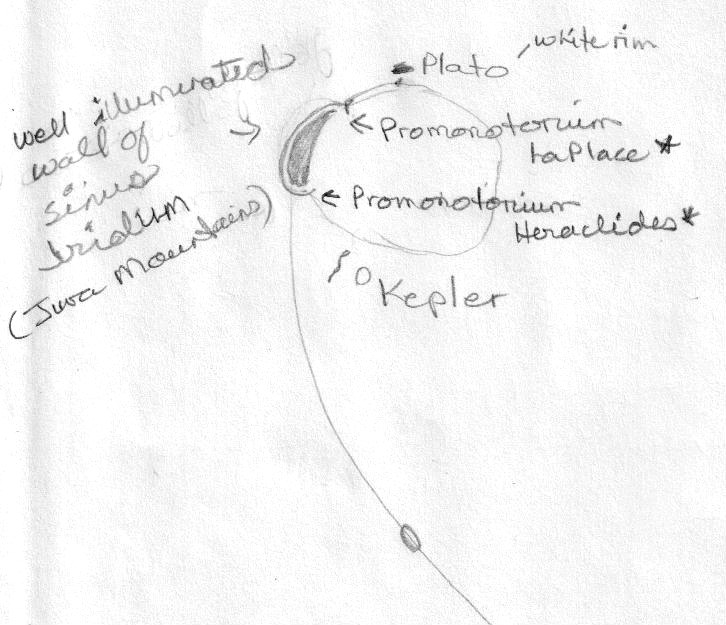 |
Craters:
Clavius, Kepler, Plato, Tycho.
Very white Gang of 4.
Mare: Crisium, Frigoris, Imbrium, Nectaris, Nubium, Serenitatis, Sinus Iridum, Tranquilitatis
Montes:
Jura: well-illuminated as was Sinus Iridum.
Promontorium Laplace and Promontorium Heraclides: Had to look up the names of the 2 promontories; they were well lit and were quite striking.
- Details
- Hits: 1599
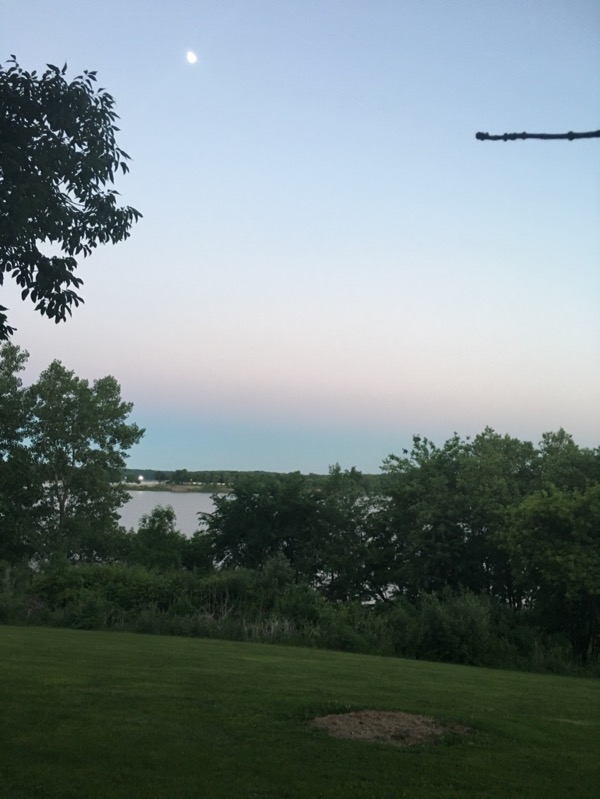 |
Lunar Phase: Waxing Gibbous (89.2%) Moonset: 5:39 AM CDT Moonrise: 7:02 PM CDT Location: Sandy Beach Campground, Iowa (near Cedar Rapids) |
Very clear skies, no cloud. Amazing night! We had frozen the night before in the Rocky Mountains but on this evening we wore shorts and t-shirts to watch the night skies evolve. Set up our camp chairs next to the tent in the open field and enjoyed watching the Moon rise. Earth's Shadow and the Belt of Venus were bonuses. The fireflies in the field’s hedging that spread before us and along the river's edge twinkled like mini-Christmas lights.
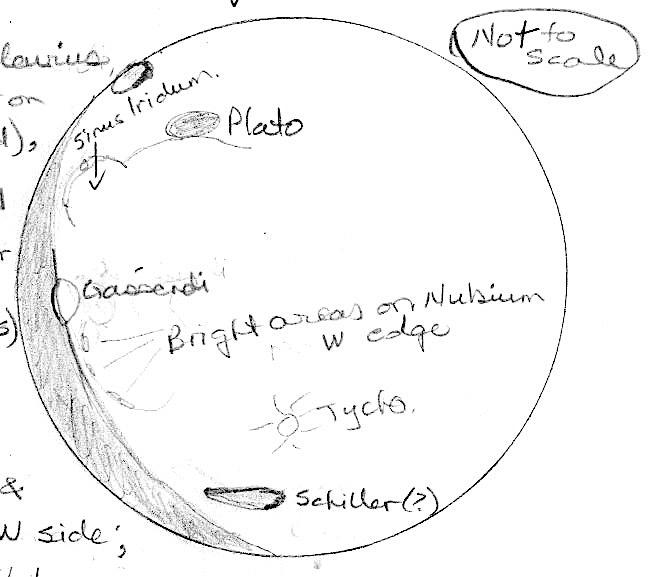 |
Craters: Mare: Crisium, Fecunditatis, Frigoris, Humorum, Nectaris, Nubium, Oceanus Procellarum, Serenitatis, Tranquilitatis Sinus: Aestuum, Iridum (NW edge showed well-lit Montes Jura), Medii Montes: |
- Details
- Hits: 1523
Lunar Phase: Waxing Crescent (4.3%)
Moonrise: 7:18 AM Moonset: 10:25 PM
Sunrise: 5:30 AM Sunset: 9:05 PM
Location: Home
Date: 2017-06-25
Time: 8:38 PM
Equipment: Binoculars 10x30 IS
Magnification: x10
Transparency: not recorded
Seeing: not recorded
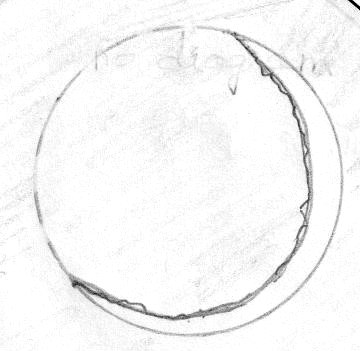 |
I looked westward out our bedroom window to see a sliver of a Moon hanging just above the treeline, with a bit of a rough edge on the terminator. Grabbed my binoculars and ran outside only to find the Moon had disappeared. I went back in thinking I was too low to see it in the backyard, only to find it had disappeared from View. So much for viewing it. :( Following this session, I went back in the house for a few hours. I went back out in the wee hours of the morning to continue observing other celestial bodies. Look at General Session - June 25-26, 2017. |
- Details
- Hits: 1663
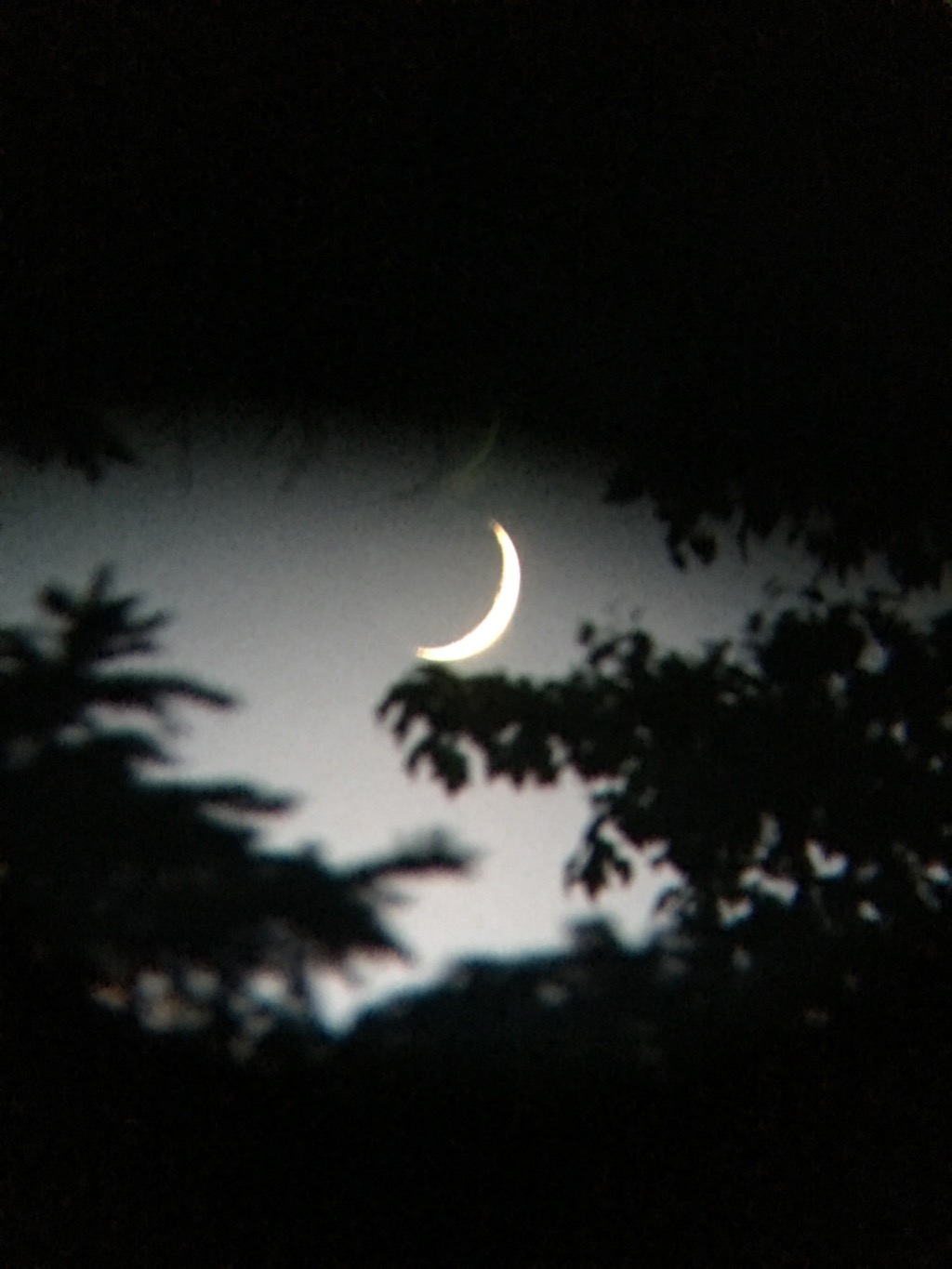
|
Phase: Waxing Crescent (10.4%) Location: St. Croix Observatory (SCO) Moonrise: 8:28 AM Moonset: 11:13 PM |
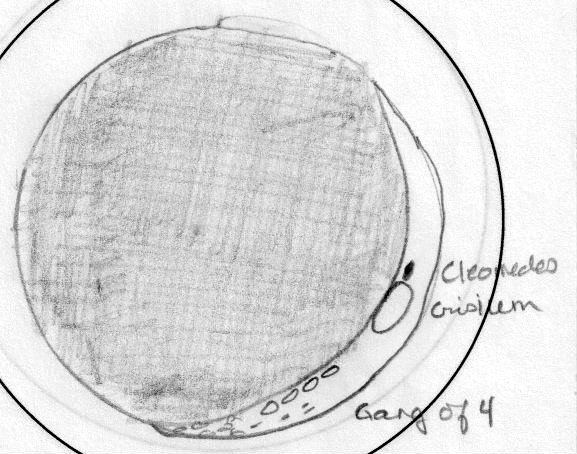 |
Cloudless night. When we arrived at SCO, the sliver of a Moon was peeking through the evergreens. There wasn't much time before it disappeared. I was able to find Mare Crisium (the western shore still in shadow at the terminator), Cleomedes, the Gang of 4 and several other craters in the lower segment of the crescent. The remaining surface of the Moon was dark but the 'full' Moon could be seen (Earthshine). When it disappeared, I went on to general observing. Here are the notes for General Session - June 26-27, 2017. |
- Details
- Hits: 1599
Lunar Phase: Waxing Crescent (29.4%)
Moonrise: 10:47 AM
Sunrise: 5:32 AM Sunset: 9:05 PM
Location: Home
Date: 2017-06-28
Time: 9:48 PM – 10:08 PM
Equipment: Visual + Binoculars 10x30 IS + 15x70
Magnification: x10 + x15
Transparency: not recorded
Seeing: not recorded
|
Mares: Craters: A strange looking large crater directly below Piccolomini – pale with a greyish crater edge and a dark spot in its centre (Stiborius or Wohler?). |
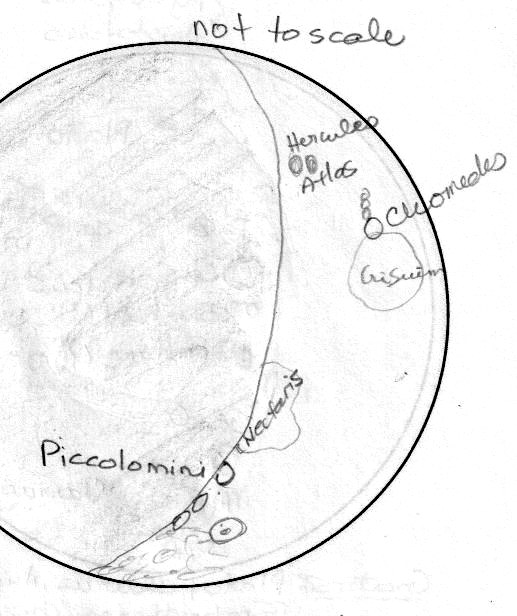 |
- Details
- Hits: 1621
Lunar Phase: Waxing Gibbous (50.1%)
First Quarter: 8:52 PM
Moonset: 12:41 AM Moonrise: 12:48 PM
Sunrise: 5:18 AM Sunset: 8:55 PM
| Location: Ottawa, ON at RASC General Assembly (GA) Date: 2017-06-30 Time: ~ 8:45 PM EDT Equipment: Visual + Binoculars 10x30 IS Magnification: x10 Transparency: not recorded Seeing: not recorded |
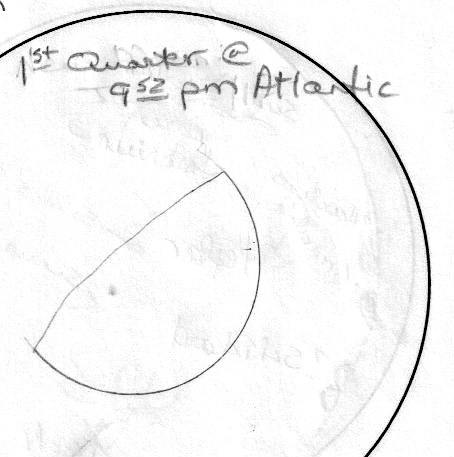 |
Travelling by bus from Ottawa to the Diefenbunker, I noticed the Quarter Moon high in the sky. I couldn’t make out any details other than the fact it was a 1/4 Moon.
I took out my binoculars and attempted to look at the terminator. Despite the image stabilization feature of the binoculars, the bus bounced too much to get a good look. There was no time to look at the Moon when we arrived and when we came out of the Diefenbunker it had clouded over. No Ottawa Star Party at the Ottawa GA.
- Details
- Hits: 1531
Lunar Phase: Waxing Gibbous (78.0%)
Moonset: 2:07 AM Eastern Moonrise: 3:54 PM Eastern
Sunrise: 5:27 AM Eastern Sunset: 8:55 PM Eastern
Location: Cottage on Bob’s Lake, South Frontenac, ON
Date: 2017-07-03
Time: 9:37 PM EDT
Temperature: 16° C
Equipment: Binoculars 10x30 IS + 15x70
Magnification: x10 + x15
Transparency: very good (5)
Seeing: very good (5)
Clear windless night with just a few clouds. Could see the Moon through the treetops. Had to move around as the Moon moved to view the terminus. Disappointed that I couldn’t stay out later - limited viewing due to the tree canopy, even from the end of the dock.
|
Craters: Mares: |
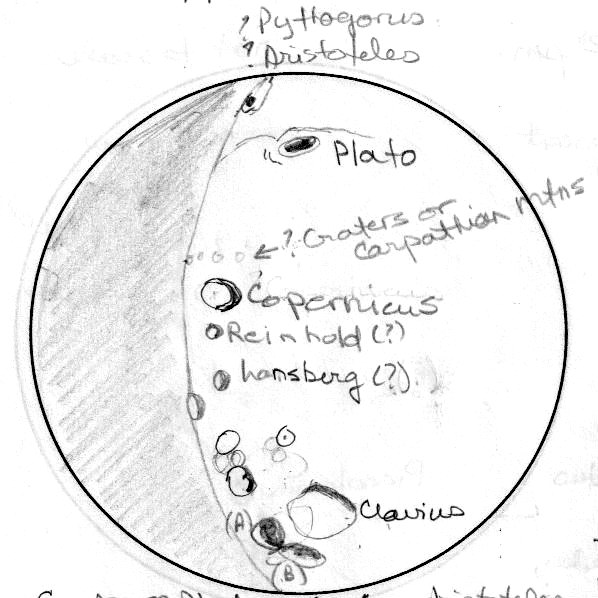 |
- Details
- Hits: 1606
Lunar Phase: Waxing Gibbous (96.0%)
Moonset: 3:36 AM Eastern Moonrise: 6:37 PM Eastern
Sunrise: 5:20 AM Eastern Sunset: 8:48 PM Eastern
| Location: Friends’ home in Cornwall ON Date: 2017-07-06 Time: 10:38 PM - 10:50 PM EDT Temperature: 17° C Equipment: Visual + Binoculars 10x30 IS Magnification: x10 Transparency: very good (5) Seeing: very good (5) |
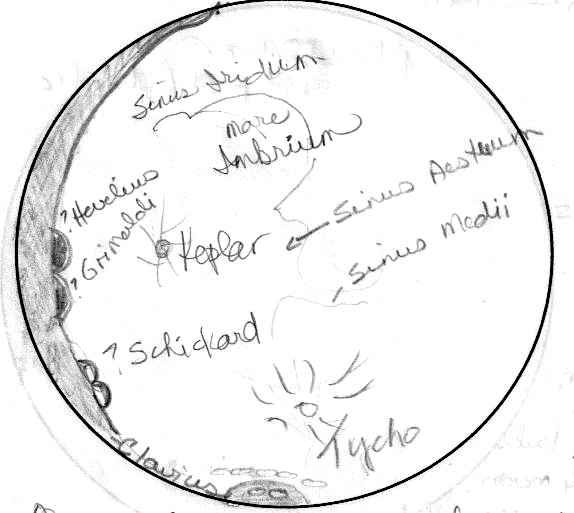 |
Clear cloudless night with no wind. Saturn could be seen below the Moon.
Craters:
Clavius (shadowed but could see craters inside/beside it)
Eastern half of Grimaldi. Its eastern edge was well lit with crater floor in darkness. Maybe Hevelius above it (?)
Also identified Kepler, Schikard, Tycho
Sinus:
Aestuum, Medii, Rorus (next to Frigoris)
- Details
- Hits: 1525
Lunar Phase: Waning Crescent (8.6%)
Moonset: 3:09 AM Eastern Moonrise: 6:13 PM Eastern
Sunrise: 5:56 AM Eastern Sunset: 8:59 PM Eastern
Location: Site 13, Kejimkujik National Park
Date: 2017-07-20
Time: 8:15 AM – 9:50 AM Eastern
Temperature: 19° C - 20° C
Equipment: Visual + Binoculars 15x70
Magnification: x15
Transparency: very good (5)
Seeing: very good (5)
Clear cloudless sky with no wind. Began looking for this thin crescent shortly after 8 AM. We made the mistake of searching low on the skyline before finding it in the SE and at about 65° - 70° above the horizon. Very difficult to find because of the clear skies and very bright sun.
With the binoculars, we could make out a dark smudge at about 8’clock. What was truly interesting was how there really wasn’t a terminator like there is at night. I could still make out the remaining part of the Moon, but it was more like a gradual diminution of light from the ‘bright’ crescent to the adjacent areas. The blue area of the Moon just blended gradually into the blue sky. Given the early hour, the sky was a beautiful blue!
Jerry had set up the binoculars on a tripod for my viewing as I couldn’t find it in my 10x30 IS. He then set up a camera on a tripod and captured a couple of beautiful pictures of the waning crescent; first picture was at 8:41 AM. We spent about an hour looking at the Moon until we could no longer see it in the brightening sky.
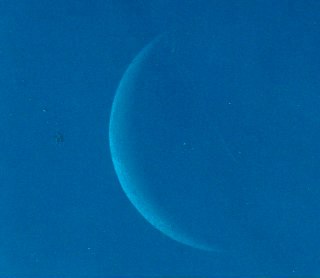 |
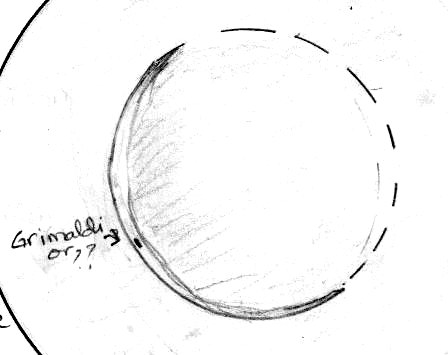 |
- Details
- Hits: 1835
Lunar Phase: Waxing Crescent (14.6%)
Moonrise: 9:36 AM Moonset: 10:53 PM
Sunrise: 5:55 AM Sunset: 8:49 PM
| Location: St. Croix Observatory (SCO) Date: 2017-07-26 Time: 9:18 PM – 9:45 PM Eastern Temperature: 15° C Equipment: Visual + Binoculars, 10x30 IS + 15x70 Magnification: x10 + x15 Transparency: good (3) Seeing: good (3) |
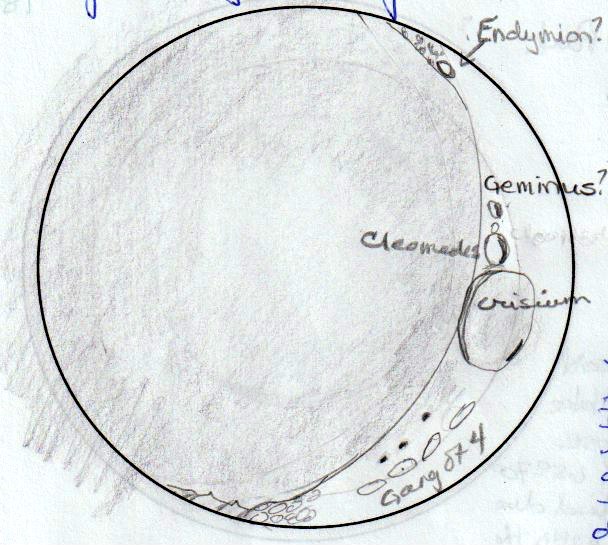 |
Clear, no clouds, light wind. Part of this evening was also general observing - General Session - July 26/27, 2017
Mare Crisium very visible. Its western edge was well lit and this edge formed part of the terminator. Dark floor in Crisium. Cleomedes seen very well above Crisium. Gang of 4 was visible. The southern end of the terminator appeared to have 3 dark valleys/shadows that made it look like a serrated edge. There were 2 more craters that I questioned as to what they were. Maybe Geminus and Endymion?
The shape of the whole Moon could be seen despite parts of it being in shadow. All limbs were visible – Earthshine.
- Details
- Hits: 1894
